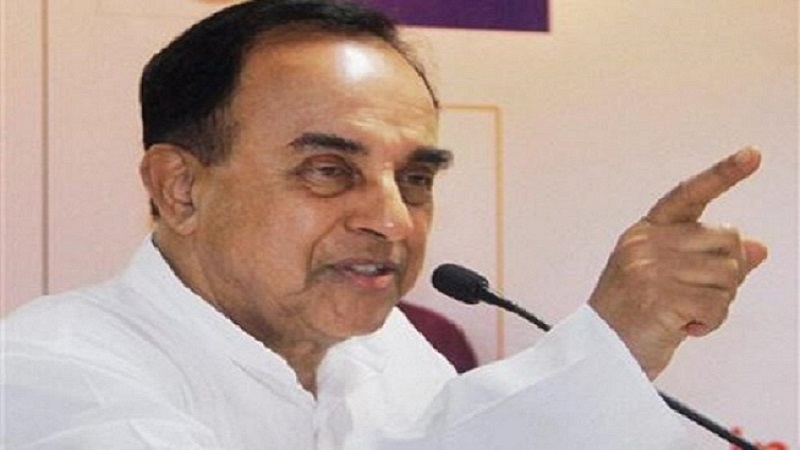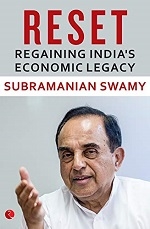RESET: Regaining India’s Economic Legacy - Dr. Swamy raises a Red flag

RESET – Regaining India’s Economic Legacy is a book that has come at a very opportune time. After a long time, Dr. Subramanian Swamy has donned the hat of an economist who left it all for serving the country when he was at the peak of his teaching career; and could have earned global accolades like his other colleagues in Harvard University.
Except for underlining his role in path breaking reforms from Chandrashekhar government to P V Narasimha Rao governments, he has stuck to his role as an economist as he goes over 150 years of India’s economic history with an analytical approach and prescribes his solution to take India to higher trajectory of higher growth rate of 10%.
It is noteworthy that he was the first economist in 1970 to challenge the socialist notion of ‘Nehruvian growth’ and wrote a monograph for Bharatiya Jan Sangh about how to reach 10% growth with swadeshi economics and dismantling the socialist regime that was a ghastly mess of mixed economy. This paper cost him his job in IIT Delhi as Mrs. Gandhi was highly offended by this young economist’s advocacy of liberal economics and dumping of Soviet model.
Dr. Swamy presents the economic history of India starting 1870, immediately after 1857 when British took firm control of India and Indian economy till 1947, from 1947 to 1991 when the socialist mixed economy model was finally dumped and the period from 1991 to 2019. According to him, by 1870, the Indian economy had already lost its verve and had been emaciated by foreign aggression and loot and pillage. Under 1870, the British regime slowly throttled the domestic entrepreneurship and killed farming by introducing zamindari that collected tax revenue. He points out that economic condition of Indians was far better under the princely states as compared the colonised parts of India directly under the British.
He underlines that there were many precipitous circumstances that got India out of Communist-Socialist quagmire of mixed economy controlled by the state in every possible way. Chief among these was the near bankruptcy of India that stared at the Chandrashekhar government in 1990 and break up of Soviet Union, thus ending its hold on Indian establishment.
The book provides huge amount of data showing multi-dimensional economic parameters in various periods to buttress his arguments but no tabulation is overpowering, as he also provides easy explanation. To provide such a bird’s eye view of 150 years in a few pages is in itself quite remarkable.
 In this historic narrative he compares the growth of Chinese economy vis-à-vis Indian economy. He has chosen these two nations as both suffered from Imperialism. He gives interesting example of how Chinese elite first opposed the railway lines in their country while Indians welcomed it. So, India had initial advantage in infrastructure. But, even though railways covered most of India well before Chinese, the British goal was only to exploit the resources by making it easier for primary products to be exported to UK at exploitative prices while taxing the industrialists and Indian traders very heavily so they were at disadvantage when they used the railways. In a way this advantage saved India during famines. China had two famines in the period of 1870 to 1950 while India had 12. But, due to better infrastructure India hardly saw any deaths while Chinese suffered nearly 32 million deaths. He shows how Indian entrepreneurs did better and produced low cost goods but were dis-incentivised by the British through various levies and various obstacles.
In this historic narrative he compares the growth of Chinese economy vis-à-vis Indian economy. He has chosen these two nations as both suffered from Imperialism. He gives interesting example of how Chinese elite first opposed the railway lines in their country while Indians welcomed it. So, India had initial advantage in infrastructure. But, even though railways covered most of India well before Chinese, the British goal was only to exploit the resources by making it easier for primary products to be exported to UK at exploitative prices while taxing the industrialists and Indian traders very heavily so they were at disadvantage when they used the railways. In a way this advantage saved India during famines. China had two famines in the period of 1870 to 1950 while India had 12. But, due to better infrastructure India hardly saw any deaths while Chinese suffered nearly 32 million deaths. He shows how Indian entrepreneurs did better and produced low cost goods but were dis-incentivised by the British through various levies and various obstacles.
The phase Two of Indian economy post 1947 was about imposing Soviet model of economy onto India. This resulted in infamous ‘Nehruvian rate of growth’ of around 3.5% wrongly called ‘Hindu rate of growth’ by establishment economists. During this period of 1947 to 1990, Dr. Swamy again brings out a comparison of India vs other economies with special attention to India vs Chinese economy. China too followed Soviet model during this time, but completely, unlike India’s mixed economy. Despite huge investments by Soviets, China too couldn’t achieve better results than 4% growth rate. While Communists realised the futility of their Communist model of development and changed course in 1980, India took another decade to move out of charade of government controlled economy run as mixed economy that gave incentive to be dishonest.
Indira Gandhi went in for more socialistic measures to buttress her popularity. Readers will recall that the word ‘socialist’ was introduced alongwith ‘secular’ in the preamble of the constitution as late as 1976 during Emergency in absence of opposition (that was in jail). But, China moved away from this model. Dr. Swamy shows how the incremental capital-output ration (ICOR) increased with more investment going to public sector with least accountability.
The first blow for liberalisation was struck in 1988 in Rajya Sabha, when Dr. Swamy through his private member’s bill that proposed abandoning the socialist model and formulate the 8th five year plan on the model suggested by Mahatma Gandhi, Sardar Patel, Jayprakash Narayan and Chaudhary Charan Singh, with principle of economic decentralisation and self-sufficiency.
Dr. Swamy begins the chapter of Indian economy post 1990 with a quote from The Economist -“Nowhere else, not even in Communist China or the Soviet Union, is the gap between what might have been achieved and what has been achieved as great as in India.” In this chapter author goes on to explain the factors behind the complete break from the past with liberalisation and removal of license raj and how India took to a new trajectory that hit a growth rate of 8%. This is the most absorbing chapter and I wouldn’t like to spoil readers’ interest by quoting from this chapter. It was an exhilarating period to which many of us are witness while the millennial kids have no idea about this journey from command control economy to a competitive open economy.
Author offers a critique of the Modi since his arrival on the national scene. He feels that bold reforms went missing and shows that the economy followed more or less the UPA period policies. According to him, the boldest move of demonetisation was marred by poor planning. Similarly, implementation of the boldest reform, GST, was again messed up by bureaucrats who created complex tax regime that made life of the people in business and industry, specially the MSME segment, difficult and economy suffered. In both cases bureaucracy was ill prepared but misguided the political masters with false assurances.
Despite denials by government sources, Dr. Swamy insists that Indian economy is in a downward spiral unless some dynamic actions are undertaken. We may or may not agree with this doomsday prediction. Considering that he had predicted slowing down of the economy much earlier, one may not take his warning lightly.
He insists that PM Modi is a great manager of micro-economics but he doesn’t understand macro-economic issues or solution. Implementation of wonderful pro-poor schemes by Shri Narendra Modi following the principles of Integral Humanism show his strength in this area. At macro level, his advisors are not telling him what is correct but only tell him what he wishes to know. This has resulted in a mess at macro-economic level according to Dr. Swamy.
Author goes onto offer some remedial measures that are quite bold. One is abolition of Income tax as the cost of collection does not justify its use as revenue collector. This would give impetus to domestic savings which supported Indian economy earlier but now are going down. He talks of lowering of interest rates, still kept high by the RBI and don’t allow industries to work at a lower cost, abolition of Participatory Notes (PN) that are a major source of black money exploited to plough it back into the system. Easing of credit to MSME, reducing rural distress and giving more push to infrastructure are other points. He talks of simplifying taxation and gives special push to exports. Two more suggestions going against current fiscal wisdom is to go for a fixed foreign exchange rate. Finally, he recommends going for higher fiscal gap, dumping the low fiscal deficit regime. However, one needs to understand these prescriptions by studying them the way he has put them in the book.
Dr Swamy claims that unless such policies are put into place, India looks at a gloomy scenario 6 months down the line. Silver lining, according to him, is that we have always come out stronger when faced with disasters.
The chapter that comes in annexure is actually the most important part of the book. This chapter explains the philosophy of Integral Humanism propounded by Deendayal Upadhyay. Not only does he simplify the philosophy in layman term, but he may be the first economist to actually convert this philosophy into a working economic model. There are many essays and books on Integral Humanism, but none of these have provided a working model. Dr. Swamy has done it successfully. This working model deserves a full-fledged book from Dr. Swamy. If policy makers care to study this annexure, they can get very good idea about major changes required to make Indian economy a dynamic tool for growth and social upliftment.
